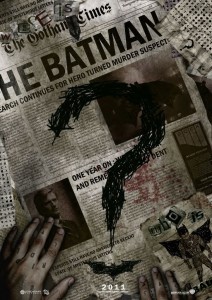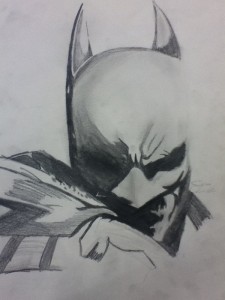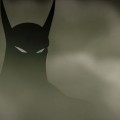With the Dark Knight Rises being released last year, superhero fan discussions inevitably turn to what the next incarnation of Batman films will be like. And it’s no wonder, the Goyer-Nolan trilogy pulled in a boatload of cash and did more to resurrect DC’s film franchises than Tim Burton, Joel Schumacher and George Clooney did to bury them with the horrible films of the 1990s. May we never return to those dark, dark days…
So, what can we do with a Batman movie that would be fun, and commercially successful?
Well, ever since the 1990s-era Bruce Timm Batman, fans have responded well to the darker modern-noir style of the Batman character. Even animated interludes like The Batman and Batman: the Brave and the Bold which were more kid-friendly still kept a fairly grim caped crusader and did the occasional episode that delved deep into Batman’s origins. The Goyer-Nolan take on the Dark Knight has been to try to bring Batman into our world as if he were a real superhero – and the fans have overwhelmingly had positive response.
So let’s not mess with success.
The Batman – The World’s Greatest Detective
Now, one of the elements that really came out of the 1970s when Denny O’Neill was writing Batman was the notion that he was the world’s greatest detective, and had spent years of his life perfecting his practice of criminology. This is something that has been missing from pretty much every Batman film that’s been tossed up on the silver screen, so let’s see if we can play with the concept and really show off a Batman whose intellect is as powerful as his fists.
Villains: In order to have a villain that is capable of matching Batman’s intellect, we’re going to want to look deep into his rogues’ gallery. Let’s first eliminate any character who has been in the Goyer-Nolan series, so that lets out Scarecrow, Ra’s Al-Ghul, Joker, Two-Face, Bane, Talia al-Ghul and Catwoman. Though really, we’re not losing too much by tossing out Bane.
Out of who’s left, we have a couple of options. The Riddler, and Dr. Hugo Strange.
As far as the Riddler goes, the Mighty Frank Gorshin casts a pretty long shadow. His interpretation of the Riddler from the Batman TV series of the 1960s has pretty much set the stage for all subsequent Riddler interpretations, including the horrible Jim Carey version. We can play with him a bit and see if we can come up with a different interpretation, but if we stray too far, then fans won’t recognize him as the Riddler. And then we end up with the same problem as Bane in the Dark Knight Rises – where the portrayal of him as anarchist was at odds with the steroid-powered mercenary that we saw in comics.
So let’s team him up with Dr. Hugo Strange. Strange has had a few incarnations ranging from mad scientist to genetic researcher to psychiatrist, but never really sat at home with the Batman universe. In several comic book incarnations, Strange was able to figure out Batman’s true identity as Bruce Wayne. He’s got a formidable intellect, and his psychiatric background gives him an edge when dealing with the inmates of Arkham Asylum. And let’s put him in the position of dominating the Riddler, who has always had psychiatric issues of leaving clues for Batman to find.
With the villains in place, let’s sketch out our story.
Theme: Some secrets should remain buried. With everything from secret identities to hidden lairs, Batman has always been about secrets, and as a detective, it is his mission to uncover those secrets. Likewise, Hugo Strange is going to be about secrets with his own agenda and trying to find out Batman’s secret identity. And what are Riddles if not secrets waiting to be told?
But what if there are some secrets that shouldn’t be uncovered? Gotham City is one of the most corrupt cities in the nation. It doesn’t just breed criminals; it breeds super-criminals – what makes it that way?
And how could the Wayne Family be a part of Gotham society for generations without some secrets of their own?
So by building our story’s theme around secrets, we have a lot of rich storytelling territory to mine.
Setting: We’ve pretty much set up Gotham as our main playground, but which parts? Let’s look at them one by one.
- Arkham Asylum: With Strange and the Riddler, Arkham’s a natural to be included. And it comes with lots of secrets of its own that we can play with. Its architect went insane and murdered construction workers on the asylum. Its founder euthanized his own mother, and personally executed a serial killer who killed his wife and daughter. Lots of Lovecraftian elements here, including an occult-inspired design.
- Wayne Manor: Pretty much a given, especially if we’re going to be exploring the Wayne family secrets.
- The Heights: Okay, I have no idea what else to call this part of town, but this is the area for the well-moneyed families of Gotham, where a lot of the older residents and their families built their fortunes on dirty money.
- The Narrows: Where Gotham City’s poor live, and home to Crime Alley – the place where Thomas and Martha Wayne were killed. This is the Batman’s natural hunting grounds, where he can tackle street thugs and corrupt cops all at once.
- Captain Gordon’s Precinct: This story works best at the early part of Batman’s and Gordon’s career, so we’re going to look at his precinct. And yeah, it will look a lot like the precinct house featured in the Batman: the Dark Knight film.
The Secret of the Batman – The Story
We’re just going to be playing around in broad strokes here, and a full-on story concept would take a lot more work. We just want to have some idea of what the story would look like from a distance.
Backstory: Gotham has always been corrupt. Always. The old-money families got their start with brokering political power and lining their pockets on city contracts. As the city grew, the city coffers financed the growth of several family fortunes, including the Waynes and the Arkhams. Neighbors and business partners once, the onset of Prohibition opened the doors to even more wealth, and for the Arkham matriarch, the lure was too tempting. She fought the upstart gangs for territory and market share, and she started looking for ways to extend her power. Encouraging a romance between her son and a Wayne daughter, she was unprepared for the backlash from the Wayne family. By the time the romance was over, Elizabeth Arkham had been murdered by her eldest son, and the Wayne daughter was sent to hospital for a “procedure” before being committed to a sanitarium to avoid prosecution for killing her own father.
The surviving Wayne family pulled back from city politics, and the City continued its slide into the hands of organized crime.
Today, Gotham is still corrupt, but there are rumors of a vigilante called the Bat Man. Gotham City PD are investigating.
Opening: Batman patrols Gotham’s streets, taking on the low-level street thugs and the corrupt cops, and the Mayor starts to demand action to keep the city from sliding into anarchy. As the head of Arkham Asylum, Dr. Hugo Strange heads up a police-civilian task force to track down the Batman.
As his assistant is the brilliant but troubled police detective Edward Nigma, nicknamed the “Riddler” for his habit of trying to show that he is smarter at crime-solving than anyone else in the room. And just to drive the point home, he always uses a big question mark on the chalkboard when lecturing the other cops. Naturally, he clashes with Captain Gordon. Gordon sees Nigma as being close to the breaking point. Still, Nigma is the official police presence on the task force, which is nicknamed “The Riddler Squad.”
With the civilian-police task force in place, the Batman now has to face off against the Gotham City PD.
Plot Point: Hugo Strange identifies Bruce Wayne as the Batman to the GCPD, and has planted evidence that implicates Bruce Wayne. Pursued by Nigma and the Riddler Squad, Bruce Wayne is cut off from his friends and allies, and from his tools. He only has a hidden Batman costume.
Complicating matters is that Strange convinces the Mayor to put a bounty on Bruce Wayne’s head, and this encourages the Gotham citizens to chase after Bruce Wayne as well.
Nigma pursues Wayne and Batman relentlessly, but Wayne manages to continually foresee and evade Nigma’s elaborate ambushes. Hugo Strange also mentions that with Bruce Wayne captured, old wrongs will be righted.
Turning Point: Hugo Strange invades Wayne Manor, and has the police escort Alfred Pennyworth out of the manor. He and Nigma then proceed to tear the manor apart, but Strange is unconcerned by evidence that points to the Batcave. Captain Gordon fights to keep the Batman on the move. Wayne meets with him and they strategize, just before Nigma bursts in on them. Nigma throws Gordon into jail for aiding a known fugitive. Nigma goes over the edge here, and it’s obvious that Hugo Strange is pulling Nigma’s strings.
In this part of the story, Bruce Wayne discovers that Strange is the descendant of Elizabeth Arkham, and that he is eager to claim the Wayne fortune, which he claims was stolen from the Arkhams following Elizabeth’s murder. He also finds that he has support of many of Gotham’s decent upstanding people who are tired of having their city run by thugs and criminals.
Climax: Batman and Captain Gordon arrive at Arkham Asylum, ready to do battle with Hugo Strange. The GCPD are on site as well, looking to take down the Batman, whom they also believe to be Bruce Wayne. Batman has to be able to take down Strange and Nigma and his Riddler Squad and somehow salvage his greatest secret – his secret identity.
Is this a Reboot?
While the general concept of a reboot is making thing completely fresh and changed from what has gone before, Batman films and animation have a winning formula, and we would be foolish to completely change what has gone before. And as much as I like the 1960s Batman with the Mighty Adam West and Burt Ward, the general fan base is not quite ready for return to camp.
The story I’ve sketched out looks at restarting Batman in “Year 2” to follow off of Frank Miller’s “Batman: Year One” graphic novel. Some of the features of this approach are:
- It maintains the darker, realistic feel of the recent Batman films, but also allows for some deeper psychological looks into the various characters including Batman, Gordon, and the citizens of Gotham. How does the discovery of Batman’s family history impact him?
- Allows for a smarter Batman, and smarter villains, while still keeping a fairly high action quotient.
- The challenge is really significant for Batman, where he faces his entire city and where his secret identity is blown early on. What will be really interesting is how a talented writer could have Bruce Wayne regain his secret identity without resorting to the old trope of dressing Alfred up in the Batman suit. I have some ideas, but I’m not telling.
- This is an origin story without actually doing an origin story. We get to see Batman developing into the legendary crime fighter we know he will become, but we also get to see the scope of the challenges he faces on his chosen path.
The disadvantages are:
- We have a lot of backstory, and doing historic scenes or flashbacks will take the viewer right out of the film, so a script is going to have to introduce the backstory in a smart way.
- Our Riddler is very different from the classic Riddler concept of the fellow in the green suit covered in question marks. But at the same time, it is a more interesting Riddler to me, and he would work well as an antagonist for Captain Gordon in much the same way as Hugo Strange works as Bruce Wayne’s antagonist.
So, that’s a starting point. What do you think? Add your comments below.
Batman and his associated characters are the property of DC Comics. No challenge to any intellectual property rights of DC Comics is made or contemplated.




